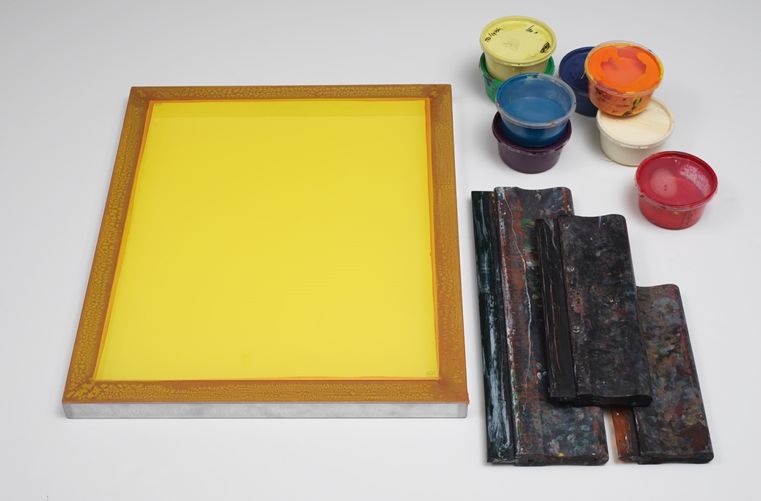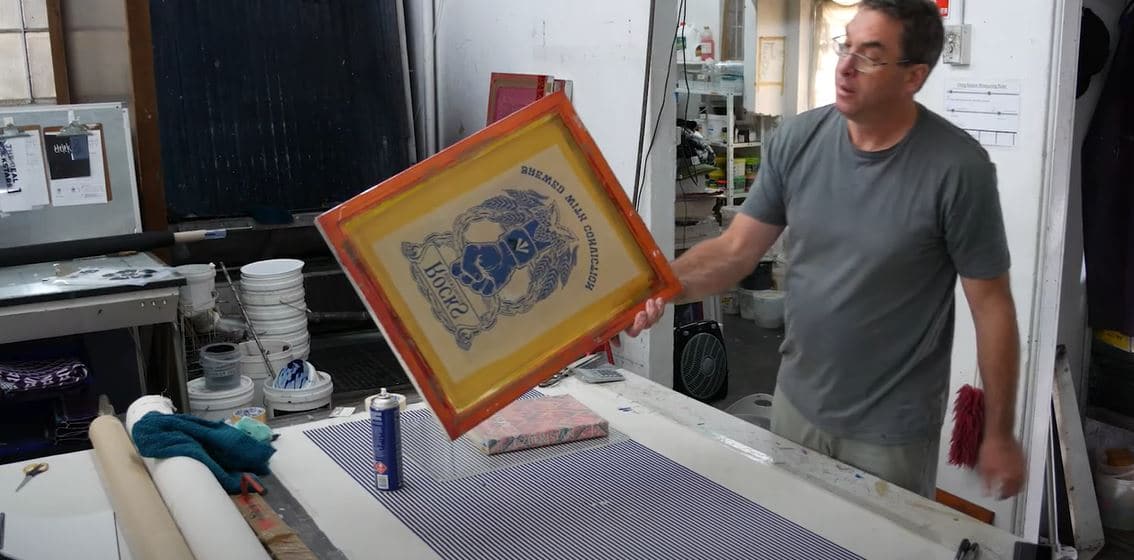ChatGPT said: The essential checklist to 10:9 Design Screen Printing Texas
Discover the Different Kinds Of Screen Printing Techniques for Your Next Job
Screen printing uses a diverse variety of techniques that can enhance any type of creative job. From conventional approaches like serigraphy to modern advancements such as direct-to-garment printing, each strategy has its unique benefits. Specialized alternatives, including eco-friendly and metallic inks, present much more opportunities. Recognizing these methods can significantly affect the final outcome. Nevertheless, the difficulty exists in choosing the most suitable approach for specific requirements and wanted results. What elements should one take into consideration?

The Essentials of Screen Printing
Screen printing may appear complex, it is essentially a simple procedure that entails moving ink through a mesh screen onto numerous surfaces. The technique begins with the production of a pattern, which defines the style to be printed. This pattern is connected to a mesh screen, usually made from polyester or nylon. When the stencil is in location, ink is related to the screen and pushed with the mesh using a squeegee, causing the desired pattern being printed on the underlying material.
Screen printing can be carried out on a vast variety of substratums, consisting of fabric, paper, and plastic, making it a flexible option for numerous projects. The process permits intricate designs and vivid shades, making it prominent in sectors such as fashion, art, and marketing. Comprehending these basics equips individuals with the foundational understanding called for to explore advanced strategies in screen printing.
Traditional Screen Printing Techniques
Standard screen printing strategies have actually been employed for centuries, protecting the craftsmanship and virtuosity of this approach. This method makes use of a mesh screen to move ink onto a substratum, such as textile or paper, permitting dynamic and lasting styles. The process begins with developing a pattern, which blocks particular locations of the screen to control where the ink will certainly be used.
One preferred technique is serigraphy, often utilized for minimal versions and imaginative prints. Another is using water-based inks, which are environment-friendly and give a soft feel on textiles - 10:9 Design LLC Company. Furthermore, standard methods can consist of manual printing, where craftsmens apply ink with a squeegee, making certain precision and attention to information
These strategies remain valued in the sector for their responsive top quality and the one-of-a-kind appearances they create, attracting both developers and consumers who appreciate the heritage of screen printing.
Digital Screen Printing Innovations
As the need for faster manufacturing and personalization in the printing market has actually surged, electronic screen printing developments have become a game-changer. This innovation mixes conventional screen printing methods with digital processes, enabling rapid prototyping and complex styles that were previously challenging to accomplish. One considerable improvement is the intro of direct-to-garment (DTG) printing, which helps with premium, full-color prints on numerous textiles without the need for displays. Furthermore, advancements in ink formulations have actually led to green alternatives that maintain lively colors while decreasing environmental impact. Making use of automated systems better improves production, lowering labor prices and enhancing accuracy. These innovations not just accommodate small batch orders and tailored layouts however likewise permit for quicker turnaround times, making them suitable for businesses concentrated on meeting consumer needs in a busy market. Digital screen printing, consequently, represents an important evolution in the domain name of printing strategies.
Specialized Screen Printing Techniques
Checking out specialized screen printing methods exposes a diverse selection of methods that push the boundaries of creative thinking and performance in the printing industry. Among these, glow-in-the-dark inks give an one-of-a-kind visual impact, making layouts come active in low-light problems. Metallic inks, known for their sparkling surface, add a touch of deluxe to published materials. Another cutting-edge technique is discharge printing, which eliminates dye from the fabric rather than including ink, leading to a soft, vintage feel. High-density printing produces an elevated structure on the surface area, enhancing responsive engagement. Additionally, water-based inks are getting popularity for their dynamic shades and reduced ecological impact. Each of these specialty techniques provides to particular style requirements, making it possible for artists and brand names to create standout items that reverberate with their audiences. By leveraging these techniques, businesses can boost their screen printing projects to brand-new heights, making certain memorable perceptions.
Eco-Friendly Screen Printing Options
Environmentally friendly screen printing options are gaining traction as the industry changes towards sustainability. Lasting ink options and using biodegradable products are vital components in decreasing the ecological impact of the printing procedure. By taking on these techniques, screen printers can contribute to an extra sustainable future while maintaining high-grade outcomes.
Lasting Ink Choices

Biodegradable Products Use
As the screen printing market evolves, the incorporation of biodegradable products is coming to be progressively important for eco conscious techniques. Makers and designers are now exploring inks and substrates made from natural, eco-friendly resources that decompose a lot more effectively than standard counterparts. These biodegradable options decrease plastic waste and decrease environmental effect, straightening with the expanding demand for lasting products.
Usual examples consist of water-based inks and organic cotton materials, both of which decrease harmful chemicals and advertise eco-friendliness. Brands that adopt these materials commonly improve their market charm, drawing in customers that prioritize sustainability. As understanding of environmental concerns remains to rise, the shift towards naturally degradable products in screen printing is most likely to obtain momentum, promoting a greener industry standard.
Picking the Right Technique for Your Task
Just how can one determine the most appropriate screen printing technique for a certain job? The decision hinges on a number of elements, consisting of the product to be printed on, the intricacy of the style, and the wanted production volume - 10:9 Design Texas. Direct-to-garment printing is perfect for elaborate designs with numerous colors, while traditional screen printing excels for bigger runs of less complex graphics.
In addition, consideration of the end-use of the printed item is essential. For outdoor applications, methods that provide durability and weather resistance, such as plastisol ink, may be preferred. On the other hand, environmentally-conscious projects may take advantage of water-based inks or naturally degradable materials.
Ultimately, understanding the project's distinct requirements enables an educated choice, guaranteeing both visual charm and useful durability. By evaluating layout intricacy, material compatibility, and manufacturing scale, one can successfully choose one of the most suitable screen printing method to satisfy their job's goals.
Regularly Asked Concerns
What Is the Background of Screen Printing?
Screen printing came from in old China around 1000 ADVERTISEMENT, progressing through Japan and Europe. By the 20th century, it ended up being prominent in industrial art and fashion, changing exactly how designs were created and distributed around the world.

How Do I Prepare Art Work for Screen Printing?
To prepare artwork for screen printing, one should assure high resolution, utilize a suitable color setting, create different layers for each shade, and convert text to outlines, ensuring compatibility with the printing process and wanted outcome.
What Products Are Ideal for Screen Printing?
The ideal materials for screen printing include high-grade inks, durable displays, and ideal substratums like cotton, polyester, or blends. Additionally, making use of appropriate solution and mops can boost the printing process and outcomes.
Can I Screen Publish in the house?
Yes, screen printing in your home is possible. With the best products, setup, and techniques, individuals can produce high-grade prints. Nevertheless, careful factor to consider of office and equipment is important for effective outcomes.

What Are Common Blunders in Screen Printing?
Typical blunders in screen printing include inappropriate direct exposure times, inadequate ink consistency, misalignment of screens, insufficient cleansing of products, and ignoring to check prints. These errors can endanger the high quality and precision of the end product.
Screen printing may appear complex, it is essentially an uncomplicated process that entails transferring ink via a mesh screen onto various surface areas. As the demand for faster manufacturing and personalization in the printing sector has actually risen, digital screen printing advancements have emerged as a game-changer. Discovering specialty screen printing techniques exposes a varied array of strategies that push the borders of imagination and capability in the printing sector. The ideal materials for screen printing include high-quality inks, resilient displays, and ideal substrates like cotton, polyester, or blends (10:9 Design Screen Printing). Common blunders in screen printing include incorrect direct exposure times, inadequate ink uniformity, imbalance of displays, not enough cleaning of materials, and ignoring to evaluate prints